Cn-down > Domestic news > News content
2022-07-25 来源:羽绒金网 浏览量:2045
summary
Recently, the frequent ordering fairs have made the down market gradually active, and the order volume has increased. At the same time, the shortage of raw material feathers has not improved, and various factors have pushed the price of down and down to continue to rise in this round. The price of goose down is relatively strong due to stable export demand and increased domestic demand.
Affected by extreme weather, the quality of raw feathers has been greatly reduced, making upstream production costs still high. At present, the market price is losing money, so the manufacturers have the mentality of waiting for the price to sell. In addition, the export of down garments has gradually entered the peak season, and the industry hopes that the domestic demand market orders will increase in volume in August and September.
The intensification of extreme weather is actually a manifestation of La Niña that has not yet disappeared. Recently, it has also brought a large wave of cold air to the northwest of my country, as well as the first snow of this summer. As far as the El Niño index is concerned, La Niña ended last month, but the index has fallen sharply recently, approaching the threshold of La Niña again.
Exchange rate of USD to RMB: 6.7447

Exchange rate of USD to RMB: 6.7451

Exchange rate of USD to RMB: 6.7465

Exchange rate of USD to RMB: 6.762

Exchange rate of USD to RMB: 6.7522

good news
On July 15, Hangzhou continued to experience high temperatures. However, in Yishang Town, Linping, an order fair for "Yishuji Seeing New Voices", which focuses on winter clothing, is in full swing. This order fair is actually very small. If you take a short walk, ten minutes is enough, but the merchants have been saturated.
At the scene, 43 exhibitors carefully selected from more than 100 clothing companies have come up with their own blockbuster products; down jackets, cashmere coats, knitted sweaters, each of which represents the fashion trend of this winter. And more than 1,400 groups of merchants will also proceed to purchase orders within 4 days.
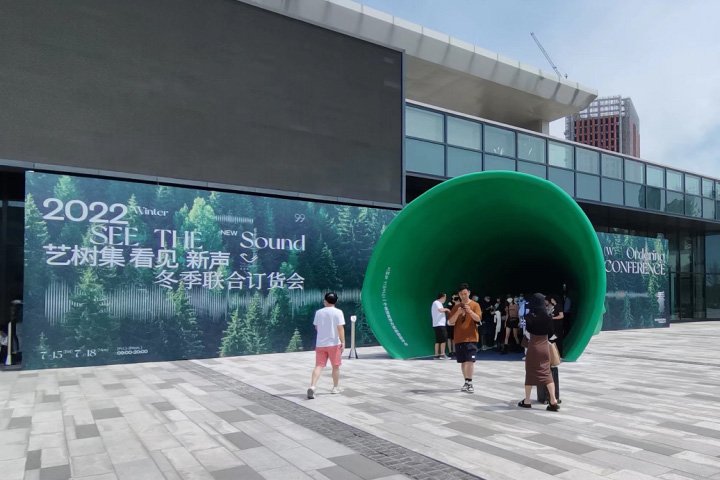
At booth 02 next to the entrance, Zhang Wencheng, the head of Hangzhou Yicheng Clothing Co., Ltd., is constantly talking to buyers who come in, introducing the styles, materials, and craftsmanship of his own clothes, and he also invites models to try them on. This time, he is ready to rush sales in the down jacket track.
He sighed again and again: "I feel that there are a lot more people today than the first day of the last order fair. The whole industry is slowly recovering and improving, which is great!"
This order fair is actually the "second episode" of this year's joint clothing order fair in Yishang Town. As the "first episode" of the autumn and winter order meeting, from May 27th to 31st this year, and Zhang Wencheng also participated.
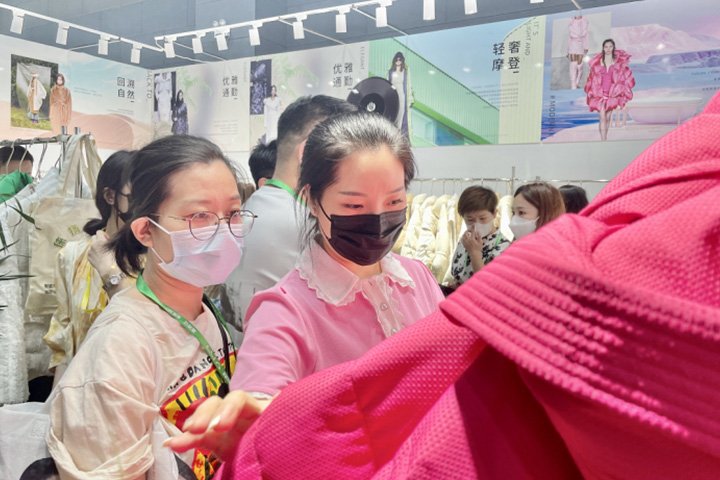
From the perspective of the industry, the scale of the order fair can only be considered small, but the total order volume of the transactions reached on the spot is more than 600,000 pieces, and the total order value exceeds 100 million yuan. In fact, the orders made by buyers at the order fair are often small orders of less than 100 pieces. However, after establishing contact, the number of orders placed by the company and the factory will be dozens or even hundreds of times that of the order fair.
"I sell in chain stores in third- and fourth-tier cities. Autumn and winter are the peak seasons for clothing sales. One of the key styles I came to buy this time is down jackets. From the products on display, they are more in line with my expected positioning, so Once you see it, you can place an order." said the Huzhou Merchant Great Sage.
It is reported that the current winter order fair starts from July 15 and lasts for 4 days. It is expected that the on-site transaction volume will exceed 100 million yuan. "The industry is recovering, business is improving, and I hope this industry will always be vibrant," said a merchant from Fujian who specializes in women's clothing store sales.

It has to be said that extreme climate phenomena around the world will be very obvious in 2022. Moreover, climate change in 2022 is likely to continue.
Judging from NASA's statistics, whether in June or July 2022, global heat wave attacks are common. In parts of Europe, North Africa, the Middle East and Asia, temperatures climbed above 40 degrees Celsius, breaking many long-term records.
Among them, according to statistical analysis, in the summer of the following year for most La Niña events, the subtropical high in the western Pacific tends to move to the north, which is one of the reasons for the continuous heat wave in my country.
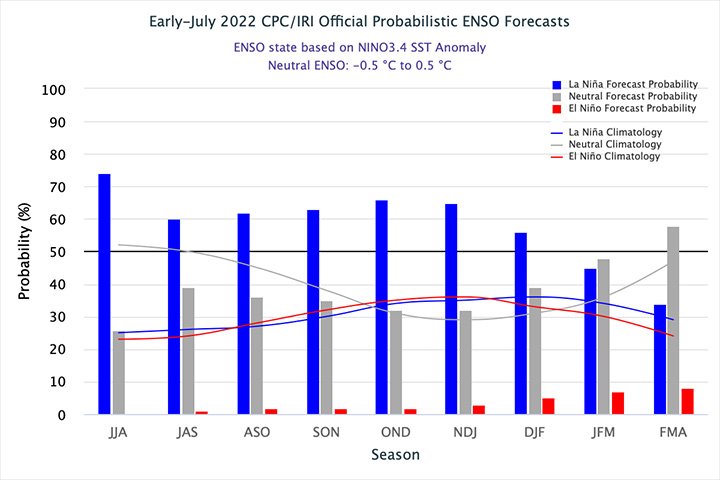
A few days ago, the Japan Meteorological Agency and NOAA of the United States successively released information on the development of the "La Niña" phenomenon.
The British "Nature" magazine has previously issued a statement that it believes that a rare "triple" La Niña climate event may occur. Now, the Japan Meteorological Agency believes that La Niña is still going on, with a 40% chance of normal for summer and a 60% chance of ending in the fall.
In the United States, NOAA believes that there is a 60% chance that La Niña will continue throughout the summer and then develop in the northern hemisphere fall and early winter at a 62-66% probability (last month's forecast was 58%).
The confidence in the forecast stems from the strengthening of the trade winds again. This helped to cool the surface waters and made the Walker Circulation in June tied for the third-highest intensity on record. And this index has a very strong correlation with La Niña.
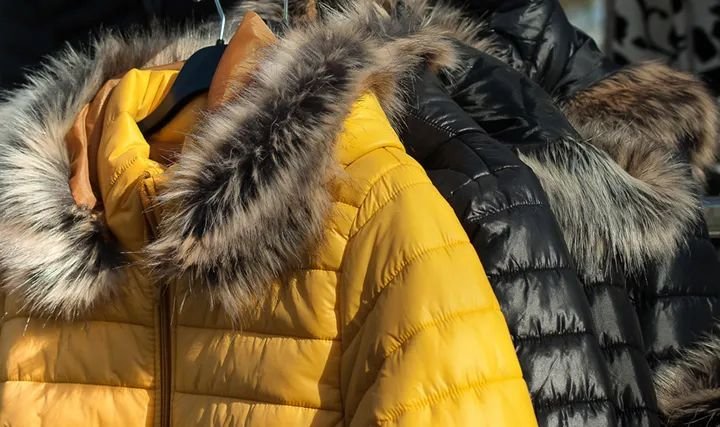
In June 2022, a total of 8.565 million pieces of down garments were exported, an increase of 25.0% from the previous month; the export value was 1.68 billion yuan, an increase of 46.0% from the previous month.
Down jacket export list in June 2022
| name | quantity | RMB(100 million) | Quantity YoY | Amount YoY |
| cotton men's down jacket | 197.1 | 2.49 | -39.5% | -36.3% |
| chemical fiber men's down jacket | 221.2 | 4.84 | 21.8% | 61.4% |
| women's cotton down jacket | 71.0 | 1.11 | 41.7% | 53.6% |
| chemical fiber women's down jacket |
367.2 |
8.39 | 31.1% |
56.8% |
Export of men's down jackets in the past 14 months
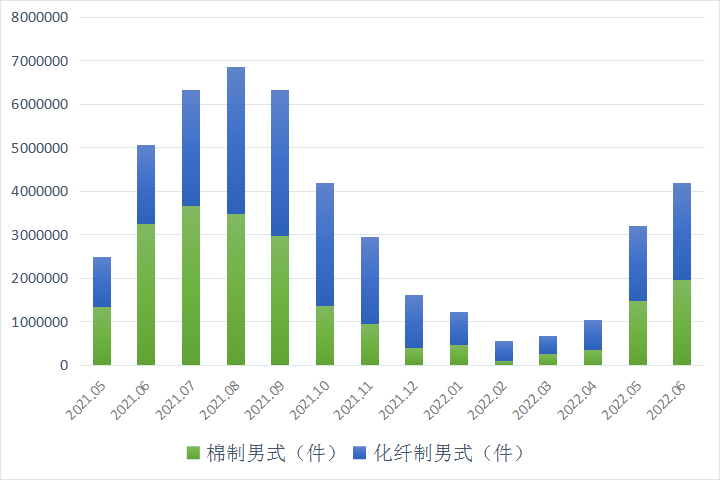
Export of women's down jackets in the past 14 months

It can be seen from the data that the export of down jackets has gone out of the off-season, but the export volume in June only increased by 2% over the same period last year.
The export volume of women's down jackets continued to maintain a relatively high growth, while the men's down jackets were the first to be affected by the ban on overseas cotton circulation in China, and the export volume of cotton men's down jackets fell sharply. It can be said that the proportion of chemical fiber down jackets in men's and women's clothing has begun to increase significantly.
In terms of imports, in June 2022, a total of 263,000 down garments were imported, an increase of 43.4% from the previous month; the import value was 326 million yuan, an increase of 68.8% from the previous month.
From January to June, Zhejiang ranked first in the country in terms of export volume and export value, and the export value was the highest in the province during the same period since 2017.
According to China Customs data, Zhejiang Province exported 10,061.9 tons of down and feathers from January to June, a year-on-year increase of 21.9%; the export value was 1.377 billion yuan, a year-on-year increase of 45.1%.
Zhejiang Province exported 1891.7 tons of down and feathers in June, with an export value of 248 million yuan.
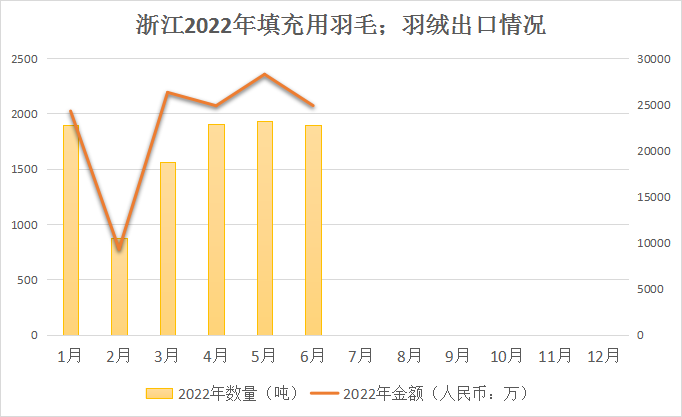
Previously, Anhui maintained the country's first export volume during the year, but was overtaken by Zhejiang in May. In June, Anhui rebounded sharply and reversed the overall export situation that should have fallen.
Anhui Province exported 9,879.0 tons of down and feathers from January to June, a year-on-year increase of 20.0%; the export value was 866 million yuan, a year-on-year increase of 64.3%.
Anhui Province exported 2,004.6 tons of down and feathers in June, with an export value of 162 million yuan.
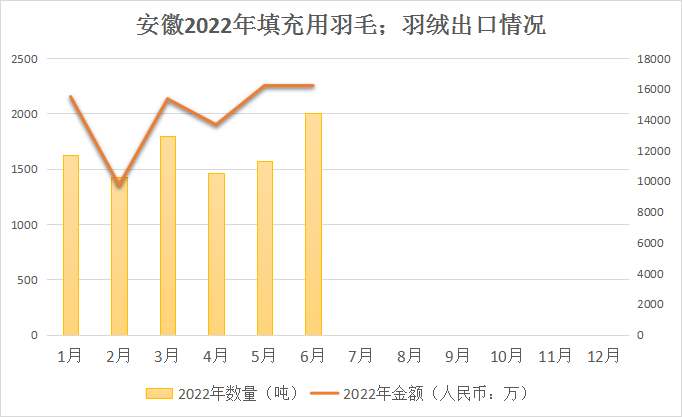
Exports from Jiangsu, Guangdong, Shanghai, and Shandong all fell sharply.
From January to June, Jiangsu Province exported 2,805.7 tons of down and feathers, a decrease of 17.5% year-on-year; the export value was 452 million yuan, an increase of 29.0% year-on-year.
Jiangsu Province exported 378.2 tons of down and feathers in June, with an export value of 55 million yuan.
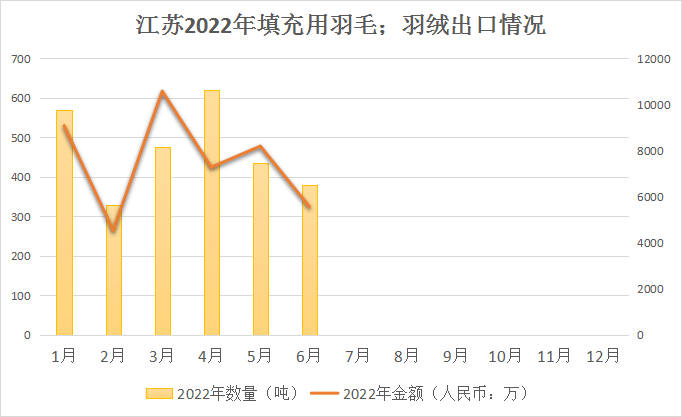
From January to June, Guangdong Province exported 1,545.9 tons of down and feathers, a year-on-year increase of 40.6%; the export value was 169 million yuan, a year-on-year increase of 4.9%.
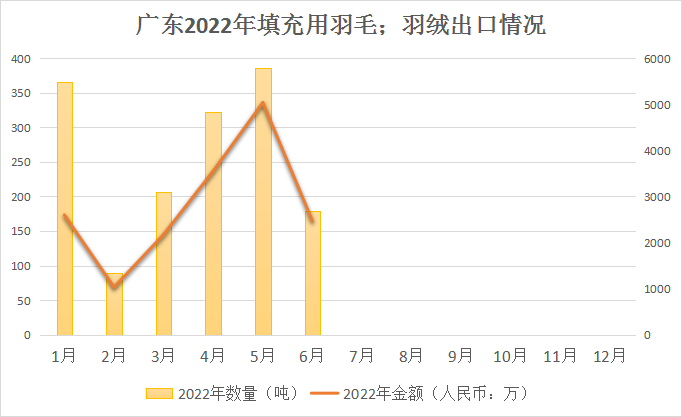
From January to June, Shanghai exported 535.3 tons of down and feathers, a year-on-year increase of 577.5%; the export value was 64 million yuan, a year-on-year increase of 176.4%.
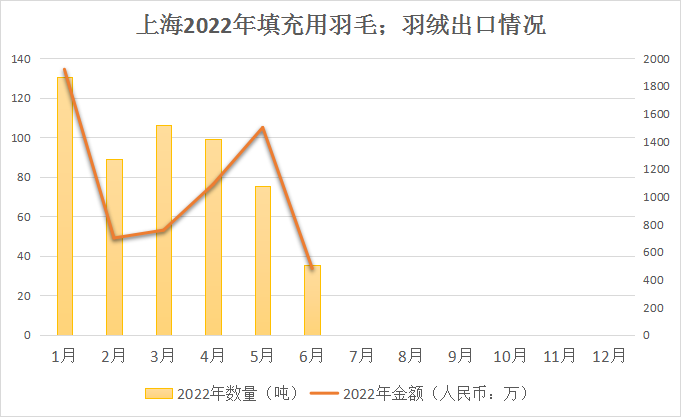
From January to June, Shandong Province exported 681.2 tons of down and feathers, a year-on-year increase of 52.9%; the export value was 98 million yuan, a year-on-year decrease of 3.2%.
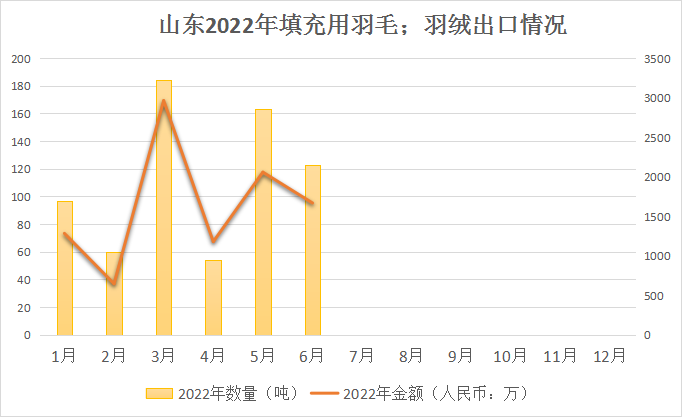
来源 |
金绒 数据来自海关
Although summer has just begun, in Nantong International Home Textiles Industrial Park, the busy production workshops of enterprises have begun to mass-produce home textile products such as thicker duvets for autumn and winter. Under the impact of unfavorable factors such as the epidemic, Nantong's home textile industry is resisting the pressure and accelerating the "restart".
On July 15, in the Mingchao home textile production workshop, colorful fabrics were being sewn into four-piece suits. "It's all to meet the demand for orders at the trade fair in mid-June, and this time the order volume has increased by about 10% compared to last year."Chairman Hu Mingliang said that with these orders, it is expected to make up for the losses caused by the epidemic this year.
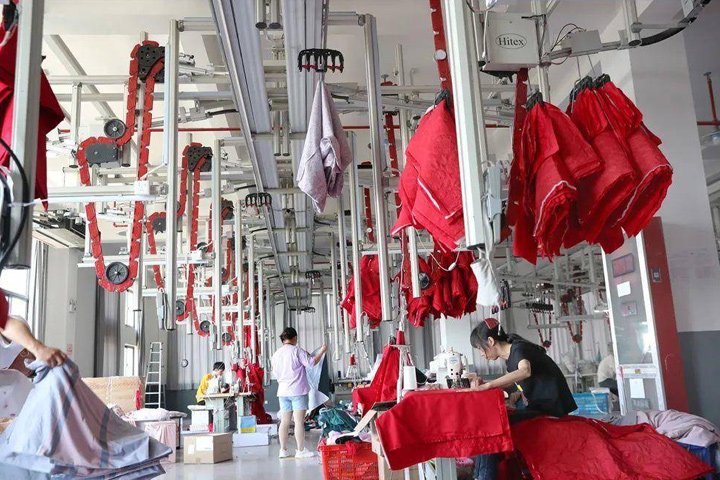
The epidemic in the first half of this year made local home textile enterprises feel the "cold". At that time, it was the peak season for production and sales of summer products. Delaying for a while was equivalent to missing a season. In fact, since the epidemic spread around the world for more than two years, the negative impact of geopolitical and trade barriers has affected the global supply chain, and Nantong's home textile industry has also suffered a greater impact.
On June 21, the 2022 China Nantong International Home Textiles (Spring and Summer) Fair hosted by the Nantong Municipal Party Committee and Municipal Government opened. Facing the tidal wave of buyers in the exhibition hall, Sun Baogang, owner of Manting Life Home Textiles, received customers while urging the factory to speed up production. "The popularity is back, and the confidence of the market is back!"
bad news
With the recent rapid depreciation of the euro and the exchange rate against the US dollar falling below the 1:1 mark, foreign trade companies on both ends of the Eurasian continent have felt a lot of shock. The heads of many Chinese foreign trade companies said that due to the depreciation of the euro and the sluggish economic growth in Europe, the order volume has dropped significantly.
Wenzhou's Mr. Qiu said, "Most of our customers are in Europe. After the depreciation of the euro against the US dollar, the local purchasing power has also declined. Many customers have cut orders. A customer in Spain has notified in advance that this year's order demand will decrease by 20%. "His biggest hope now is to have an order, "even if he loses money, he is willing to do it."

The price increase of "Made in China" brought about by the depreciation of the euro has also caused headaches for European importers. A trader who runs a home appliance store in Hamburg, Germany, said that for a TV made in China that used to cost 300 euros, consumers now need to pay about 50 euros more.
However, he also mentioned that while the euro has depreciated, the cost of container transportation from China to Europe has been greatly reduced recently. Prices for a 40-foot container from Shanghai to Hamburg have fallen below 7,000 euros, compared with more than 10,000 euros in the second half of last year, allowing European importers to keep some goods on hold.
 热门排行
中国三大羽绒生产基地之—广东吴川
全球最奢侈羽绒服排行
一件羽绒服需要多少只鸭子的羽绒?
2017羽绒原料价格一路上涨,究竟为何?
飞丝是什么?能代替羽绒?别被骗了,三种方法让你告别假羽绒服!
你的羽绒服为什么钻绒?涨知识了
羽绒被的价格一般是多少 通过成本看羽绒被价格
中国羽绒服四大品牌调查:到底谁才是最强王者?
羽绒金网:羽毛、羽绒、毛绒计价
《羽绒羽毛》、《羽绒羽毛检验方法》新版标准发布,2017年7月1日实施
热门排行
中国三大羽绒生产基地之—广东吴川
全球最奢侈羽绒服排行
一件羽绒服需要多少只鸭子的羽绒?
2017羽绒原料价格一路上涨,究竟为何?
飞丝是什么?能代替羽绒?别被骗了,三种方法让你告别假羽绒服!
你的羽绒服为什么钻绒?涨知识了
羽绒被的价格一般是多少 通过成本看羽绒被价格
中国羽绒服四大品牌调查:到底谁才是最强王者?
羽绒金网:羽毛、羽绒、毛绒计价
《羽绒羽毛》、《羽绒羽毛检验方法》新版标准发布,2017年7月1日实施
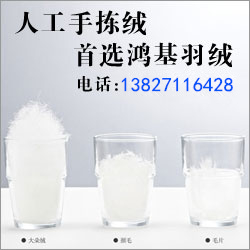 推荐阅读
“吴川力量”助中国羽绒接轨世界
中国三大羽绒生产基地之—广东吴川
中羽协第二期新国标培训班 在“羽绒之乡”广东吴川成功举办
羽绒之乡:贵港桥圩镇将打造旅游休闲特色小镇
广西贵港桥圩镇:打造中国羽绒休闲旅游特色小镇
羽绒金网:羽毛、羽绒、毛绒计价
羽绒别急着收 中央气象台发布寒潮蓝色预警 部分地区降温超12℃
上海消保委检测 千元鹅绒被用鸭毛绒填充
冻哭丨降温10℃!鸡年首个寒潮预警来袭,你准备好了吗?
传统羽绒产业如何实现转型升级?四川玉泉镇产业集群发展
推荐阅读
“吴川力量”助中国羽绒接轨世界
中国三大羽绒生产基地之—广东吴川
中羽协第二期新国标培训班 在“羽绒之乡”广东吴川成功举办
羽绒之乡:贵港桥圩镇将打造旅游休闲特色小镇
广西贵港桥圩镇:打造中国羽绒休闲旅游特色小镇
羽绒金网:羽毛、羽绒、毛绒计价
羽绒别急着收 中央气象台发布寒潮蓝色预警 部分地区降温超12℃
上海消保委检测 千元鹅绒被用鸭毛绒填充
冻哭丨降温10℃!鸡年首个寒潮预警来袭,你准备好了吗?
传统羽绒产业如何实现转型升级?四川玉泉镇产业集群发展